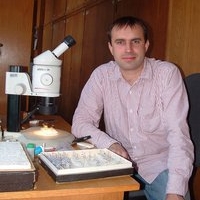- University of Oslo
Natural History Museum
Department of Zoology
P.O. Box 1172 Blindern
NO-0318 Oslo
NORWAY
Nikolai Yunakov
University of Oslo, Zoological Museum, Department Member
Morphometry and diagnosis of Rhinomias forticornis (Boheman, 1842) are given. Distribution of Rhinomias forticornis is analyzed using known occurrences, original ecological data, correlative species distribution modeling with aspect on... more
Morphometry and diagnosis of Rhinomias forticornis (Boheman, 1842) are given. Distribution of Rhinomias forticornis is analyzed using known occurrences, original ecological data, correlative species distribution modeling with aspect on Last Glacial Maximum environment are given. To achieve a more realistic and precise spatial pattern, selected climatic variables are combined with remote sensing vegetation indices (LAI and NDVI). Presumable geographic limits of realized niche are Rhine River and Elbe River on the northwest, Dniester River on the northeast. The southeastern barrier in the Carpathians is possibly Tisza River. Since the natural climatic barrier in Asia Minor, it is definitely absent in the Caucasus despite the existence of suitable bioclimatic conditions. This is the first confirmation of Rh. forticornis in Ukraine.
Research Interests:
During examination of Bagous tubulus Caldara et O’Brien, 1994 series collected in Lviv Region of Ukraine the epizoic algae were detected. Small- and medium-sized green spots are constrained to the dorsal and lateral surfaces of pronotum,... more
During examination of Bagous tubulus Caldara et O’Brien, 1994 series collected in Lviv Region of Ukraine the epizoic algae were detected. Small- and medium-sized green spots are constrained to the dorsal and lateral surfaces of pronotum, elytra, and femora of beetles. We assume that succidations, microstructure of scales along with semiaquatic way of life provides optimal substrate for growth of algal mats. It is still unclear how algal mats affect beetle life or properties of scales and coating. Taxonomic composition of those mats is unknown yet. According to available data on epizoic organisms, we presume that it may be the species of Ulvophyceae, Chlorophyceae, and/or Cyanobacteria.
Pachyrhinuslethierryi (Desbrochers des Loges, 1875) is a Mediterranean weevil species that has become remarkably well known as a result of a series of recent introductions across Western and Central Europe. This species has recently... more
Pachyrhinuslethierryi (Desbrochers des Loges, 1875) is a Mediterranean weevil species that has become remarkably well known as a result of a series of recent introductions across Western and Central Europe. This species has recently reached Asia Minor and the Crimean Peninsula, as confirmed by several new records. The vectors of invasion in Crimea and possible further expansion are suggested.
Research Interests:
Research Interests:
Our knowledge of Ukrainian bark and ambrosia beetles (Coleoptera: Curculionidae: Scolytinae and Platypodinae) is summarized as a baseline for future studies of the fauna, with a checklist including information on distribution, host trees,... more
Our knowledge of Ukrainian bark and ambrosia beetles (Coleoptera: Curculionidae: Scolytinae and Platypodinae) is summarized as a baseline for future studies of the fauna, with a checklist including information on distribution, host trees, biology and taxonomy. One hundred twenty-two species are recorded from Ukraine, of which seven are recorded for the first time. One species is recorded for the first time from Europe. Previous records of 24 species are considered dubious and requiring confirmation. In contrast to the Palaearctic Catalogue (Knížek 2011b), we consider Anisandrus maiche to be first described by Kurentsov (1941) rather than by Eggers (1942); A. maiche (Eggers, 1942) is a junior synonym of A. maiche (Kurentsov, 1941).
Research Interests:
A review of the subgenus Metaphyllobius Smirnov of the weevil genus Phyllobius Germ. is given. The name Ph. maculatus Tournier, 1880 is restored from synonymy with Ph. pomaceus fessus Boheman, 1843. A new synonymy is established: Ph.... more
A review of the subgenus Metaphyllobius Smirnov of the weevil genus Phyllobius Germ. is given. The name Ph. maculatus Tournier, 1880 is restored from synonymy with Ph. pomaceus fessus Boheman, 1843. A new synonymy is established: Ph. maculatus Tournier, 1880 (= jacobsoni Smirnov, 1913, syn. n.). Ph. fessus Boheman, 1843 is downgraded to a subspecies of Ph. pomaceus Gyllenhal, 1834—Ph. pomaceus fessus Boheman, 1843, stat. n. Data on the distribution and hosts of, and a key to European and Siberian species of the subgenus Metaphyllobius are given.
